CSD 673 - HA I - microphones
1/79
Earn XP
Description and Tags
use for test #2
Name | Mastery | Learn | Test | Matching | Spaced |
|---|
No study sessions yet.
80 Terms
transducers
devices that transform energy from one form of energy to anouther form of energy
microphone
receiver
microphone
transduce acoustic energy to electrical energy
receiver
converts electrical (output of amplifier) to acoustic energy to the ear
amplifier
amplifies electric signal
battery
supplies power
microphone
a type of transducer that changes acoustical energy (sound wave) into electrical energy (electrical voltage)
brief history of microphones
Carbon microphones (early 1900s)
Crystal microphones (mid 1930s)
Magnetic/electromagnetic (mid 1940s)
Ceramic Microphones (late 1960s)
Electret Condenser microphone (1970s)
Silicon Microphones/ Micro-Electronic-Mechanical Systems (MEMS)
Carbon microphones
(early 1900s) 1st electrical HA, restricted bandwidth, large distortion
Crystal microphones
(mid 1930s)
didn’t require external power source
wider frequency response than previous microphones
used piezoelectric salt crystals; vulnerable to heat & moisture
Magnetic/electromagnetic
(mid 1940s)
used mainly in body worn aids
size, low impedance and energy efficiency — became common when transistor aids were introduces
Ceramic microphones
(late 1960s)
modern version of the crystal mic (Piezoelectric)
more stable and resistant to shock than electromagnetic
Electret Condenser Microphone
(1970s)
low resistance to mechanical vibratino/better resistance to shock
uses a type of capacitor which has a permanent voltage built into it
doesn’t require any external power for operation
good ones usually include a pre-amplifier (still requires power)
currently used in the VAST MAJORITY of HAs
Today’s smallest electret HA occupies only .02 cm³ — a reduction in volume of __ times compared with microphones 50 years ago
150
In a microphone, sounds enter __ port and reach the diaphragm
inlet
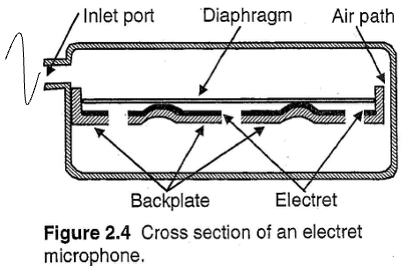
Pressure fluctuations within the sound wave cause diaphragm (aka front plate) to move ___
up and down
air path
small air space separates diaphragm from a rigid metal plate (back plate)
back plate
coated with thin teflon material called electret
electret
material has a permanent change
When sound pressure forces the diaphragm towards the electret, the closer diaphragm and electret, the ___ charge on the diaphragm
greater
Think of the front and back plates as forming a ___.
capacitor
Capacitor
an electronic component that has reactance (rather than resistance) because it stores energy in the form of an electrostatic field
used to convert acoustical energy into electrical energy
The front plate is made of very light material and acts as the ___
diaphragm
The diaphragm vibrates when struck by sound waves, moving the font and back plates ___ to each other
closer
When plates are closer together, capacitance ___ and a charge current occurs.
increases
When the plates are further apart, capacitance ___ and a discharge current occurs.
decreases
Capacitance
amount of charge the capacitor can store per voltage
Capacitance and reactance are ___ related
inversely
Silicon Microphones/ Micro-Electronic-Mechanical Systems (MEMS)
still vastly under development, but currently used in Starkey hearing aids
Advantages of Silicon Microphones/ Micro-Electronic-Mechanical Systems (MEMS)
Extremely small and low vibration sensitivity because diaphragm is so thin
HA mic may be produced on same chip as HA amplifier
significantly decreases HA component size
Disadvantage of Silicon Microphones/ Micro-Electronic-Mechanical Systems (MEMS)
relatively high internal noise
Hearing Aid Microphone Frequency Response
•Should ideally have a flat frequency response with a wide dynamic range
•Should be equally sensitive to all frequencies across its frequency range
Two General Types of HA microphones
Omnidirectional & Directional
omnidirectional
One sound inlet
Signals processed equally regardless of azimuth/ equally sensitive to sound coming in from all angles
Azimuth/angle
Equally sensitive to every angle
Directional
Two sound inlets
More sensitive to sound coming from one direction than from another direction
Ideally more sensitive to sound coming from the front than to sound coming from other directions
Want 0 degrees (front)
Signal-to-Noise Ratio (SNR)
Relationship between the loudness of the desired speech signals and the undesired noise background
As reverberation increases, SNR ___
decreases
signal 70 dB, noise 65 dB, = __ dB SNR
+5
signal 70 dB, noise 75 dB, = ___ dB SNR
-5
signal 70 dB, noise 70 dB, = ___ dB SNR
0
directional microphones
Sounds coming from the front are given priority compared to sounds arriving from other directions.
Directional mics depend on
spatial separation of the noise and signal.
When using directional mics, the patient should position themself so that signal is in ___ and noise behind or off to the side
front
In directional mics, the greatest increase in speech recognition in the presence of noise is achieved by
reducing distance between speaker and microphone
Placing the microphone close to a talker’s mouth, the __ signal is louder at the microphone than are the background noises
speech
Two types of directional microphones
single directional microphones & dual microphones
external time delay
time it tkes for sounds to get from one inlet port to the other
internal. time delay
rear port contains an acoustic damper, which adds resistance and provides a time delay equal to the external delay of the same sound traveling from the rear to the front port
result of internal time delay
sounds coming from the rear direction hit the front port later than the rear port and signal from the back become out of phase at the microphone and cancel
In single directional microphones, __ sound entry ports going to ONE microphone
two
In single directional microphones, the diaphragm motion is driven by the ___ in pressure on its two sides
difference
Directional mics usually provide ___ low-frequency gain than omindirectional mics due to greater similarity in the amplitude and phase at the 2 mic ports for the low-frequency waveforms
less
dual microphones
most commonly used in today’s hearing aids
Employs two omnidirectional mics for improved directionality
BTEs – allow maximum distance between 2 ports to be ~15mm,
ITE is reduced to 4-10 mm.
Greater distance, better directionality
Output from 2nd mic is electronically delayed and subtracted from 1st mic output.
In dual microphones, the two omnidirectional mics must have equal ___
sensitivity
dynamic matching
hearing aid constantly compares the relative sensitivity of the two microphones (dual microphones)
A hearing aid with dual microphones can still be put in omnidirectional moder, if a hearing aid is set to this mode, how many microphones is it using?
1 out of the 2
Multi-Microphone/Beamforming Arrays
combines outputs of 2 or more directional mics or more than 2 omnidirectional mics
research shows little additional benefit is achieves when the number of mics exceeds 5
Patients can be fit binaurally
polar plots
plot microphone output as a function of the angle of sound incidence
describes the directional sensitivity of microphones
cardioid microphone design
max attenuation from rear (180 degrees)
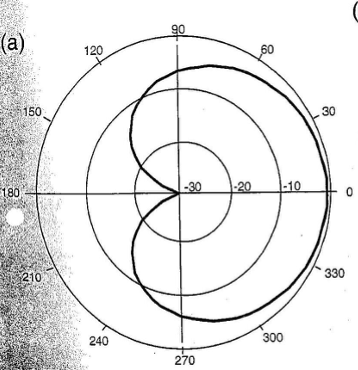
super-cardioid
sensitivity to sounds in back grows, but sensitivity to sounds on side diminish
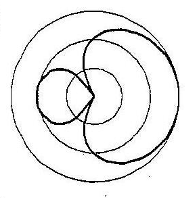
hypercardioid
max attenuation at 110 degrees and 250 degrees
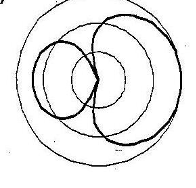
bi-directional
max attenuation at 90 and 270 degrees
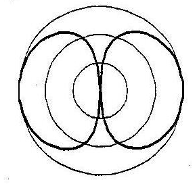
directional hearing aid features
automatic switching & adaptive polar patterns
automatic switching (directional HA feature)
-HA will detect the level of the spectrum (speech, noise or music) and the direction (front, back side) of the sounds
-based on this information, the hearing aid will “automatically switch” to the best microphone mode (omni or directional) for that listening environment.
- algorithms vary across HA companies
adaptive polar patterns (directiona HA feature)
Polar patterns can be changed by changing the electronic delay between the two omnidirectional microphones.
-HA samples all polar patterns and then locks on the one that results in the best output or maximum attenuation of noise.
-Also, can track a moving noise source from behind by keeping the null of the polar pattern located on the noise source.
problems with microphones
break down if exposed to perspiration and other chemical agents
random electrical noise — all electronic components generate small amounts of noise
sometimes audible in quiet environments
sensitivity to vibration of mic generates a voltage reflecting the magnitude and frequency of the vibration (e.g., Clothing next to body, running on hard surface, wind noise)
factors that limit effectiveness of directional microphones
Venting/open fittings negatively affects directivity
open fittings and hearing aids with large vents only maintain directionality in the high frequencies
Microphone ports need to be aligned on the horizontal plane
Directional microphones reduce low frequency output
need to increase amplification of low frequencies to compensate
Measures of Directionality
Directivity Index (DI)
Articulation Index — Directivity Index (AI-DI)
Front to back ratio (FBR)
Directivity index (DI)
One number in dB that represents ratio of the mic output for signals from the front (0 degrees) to sounds originating from all directions
DI Ranges
0-1 dB (or less than 0) → Omnidirectional
4-6 dB → Directional microphone
12-14 dB → Multiple array microphone
higher DI =
better directionality
every 1 dB improvment in DI increases speech recognition by
7-10%
Articulation Index provides measure of the percent of speech energy that is __
audible
Articulation Index has different weights for contribution of each frequency band to the overall intelligibility of speech (e.g. AI applies a weight of .0010 for 250 Hz, .0024 at 1K, .0038 at 2K) and is Measured on a __ scale
0-1
AI-DI
Directivity Index at each frequency is calculated by multiplying the AI weight and then performing a RMS sum of resulting products to equal one number
A directional microphone that extends to __ frequencies will have higher AI – DI because high frequencies contribute more to intelligibility than other frequencies
higher
Front-to-back Ratio (FBR)
difference between the frequency response of the mic with the signal presented from the front and rear
What is the FBR of omnidirectional?
0
Directional microphones have a greater separation of front/back signals, which means it will have what kind of FBR?
greater
a greater FBR is only good for what kind of microphone?
cardioid, with a null at 180 degrees
FBR only give info about suppressing noise directly __ the person
behind